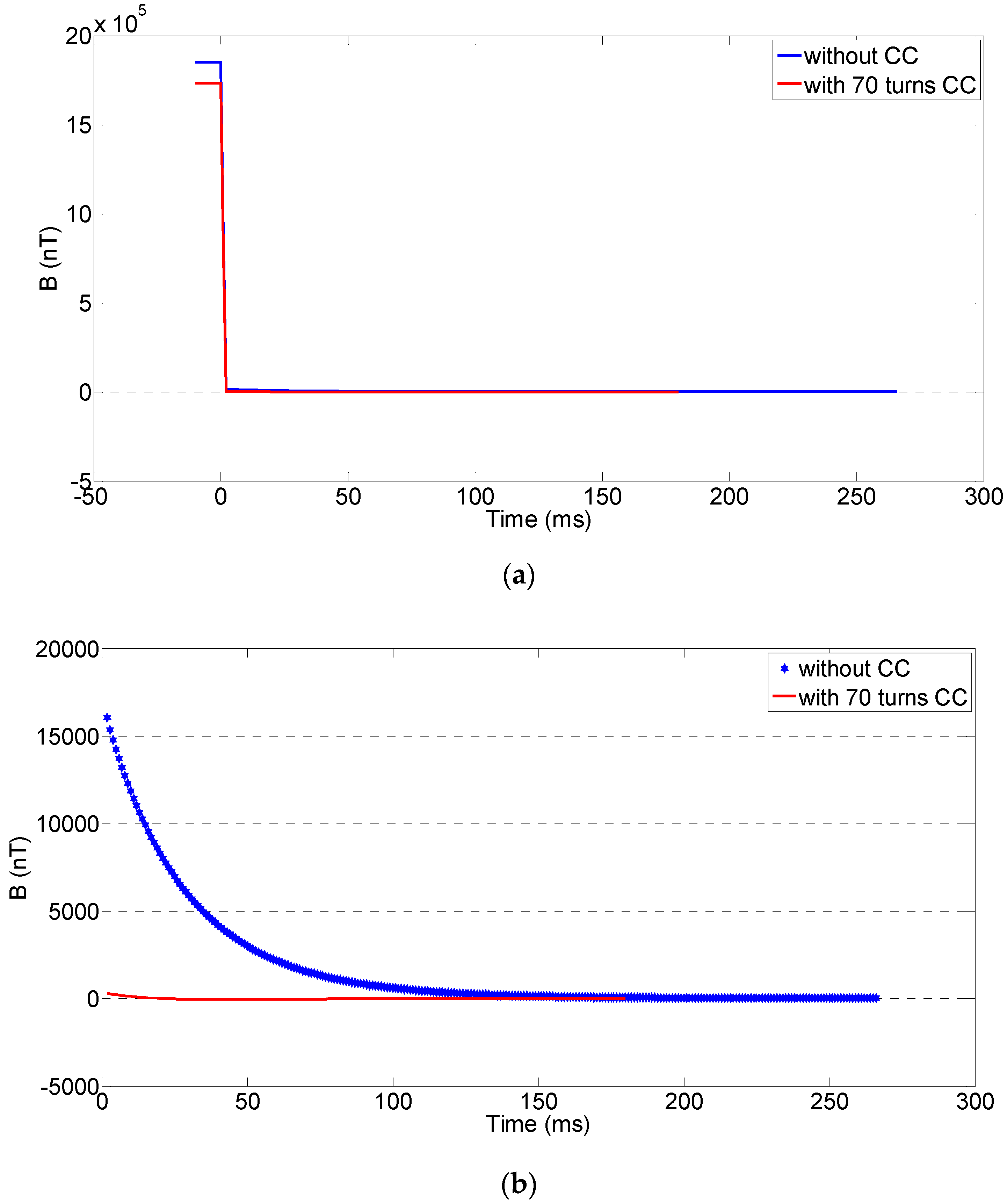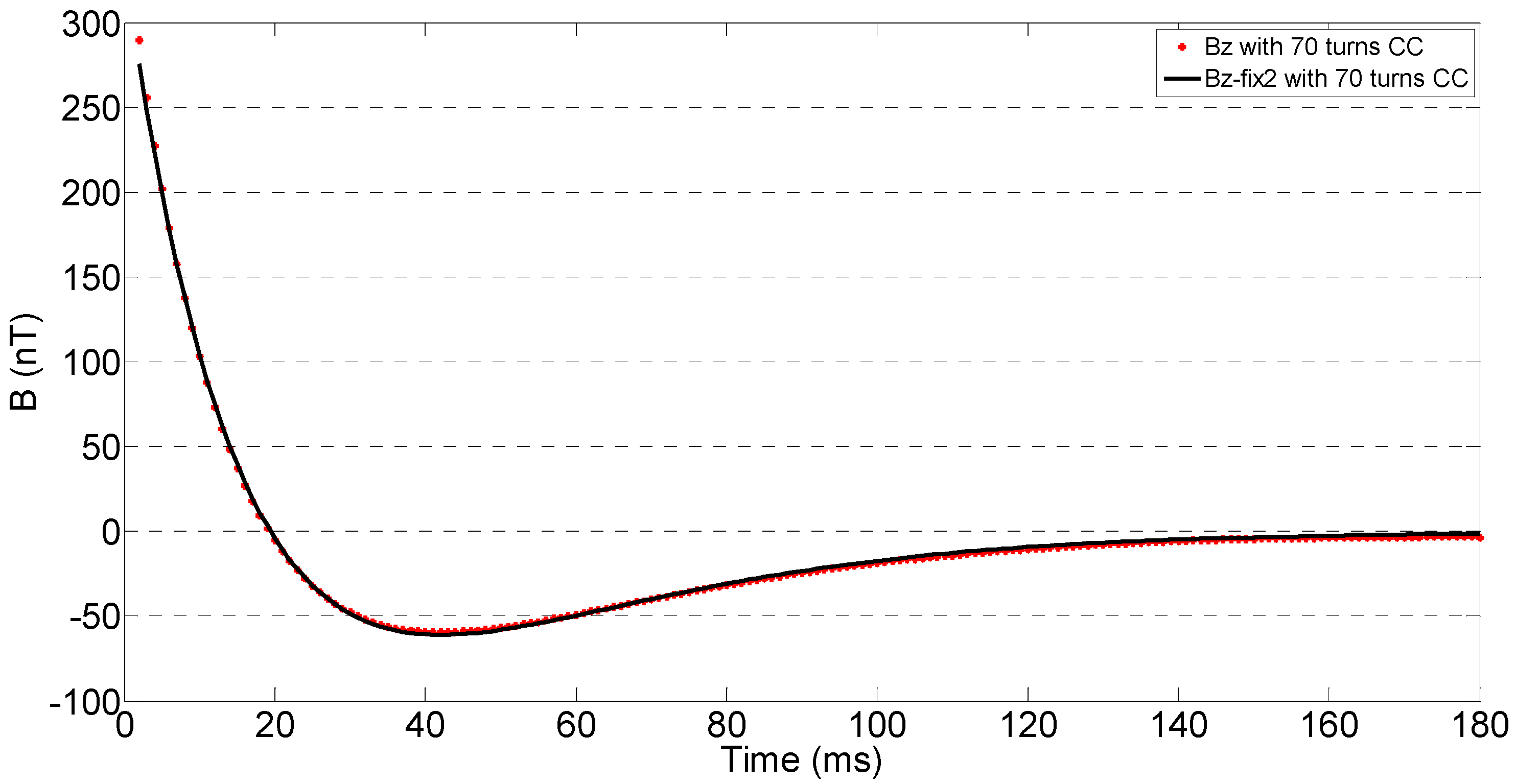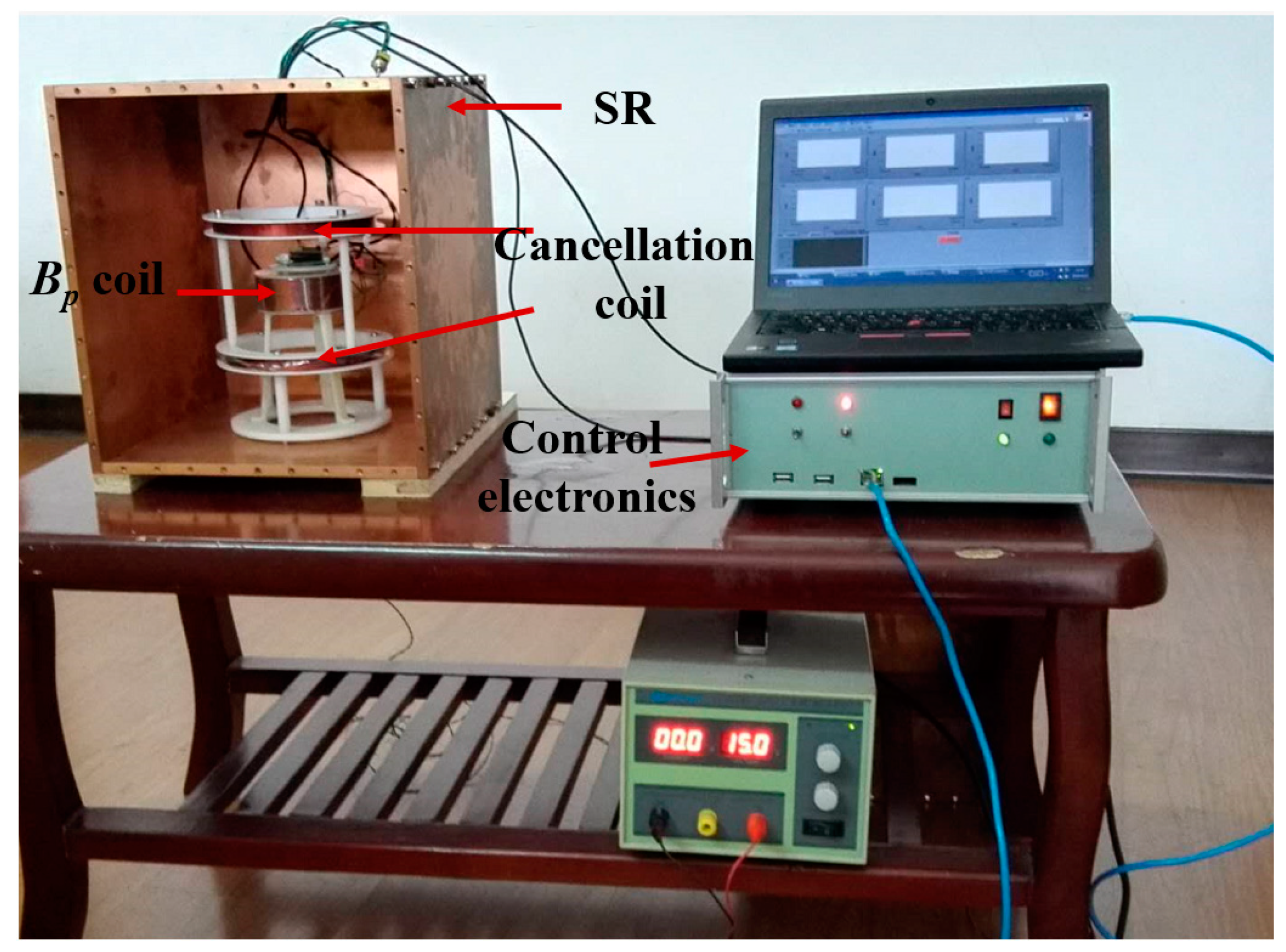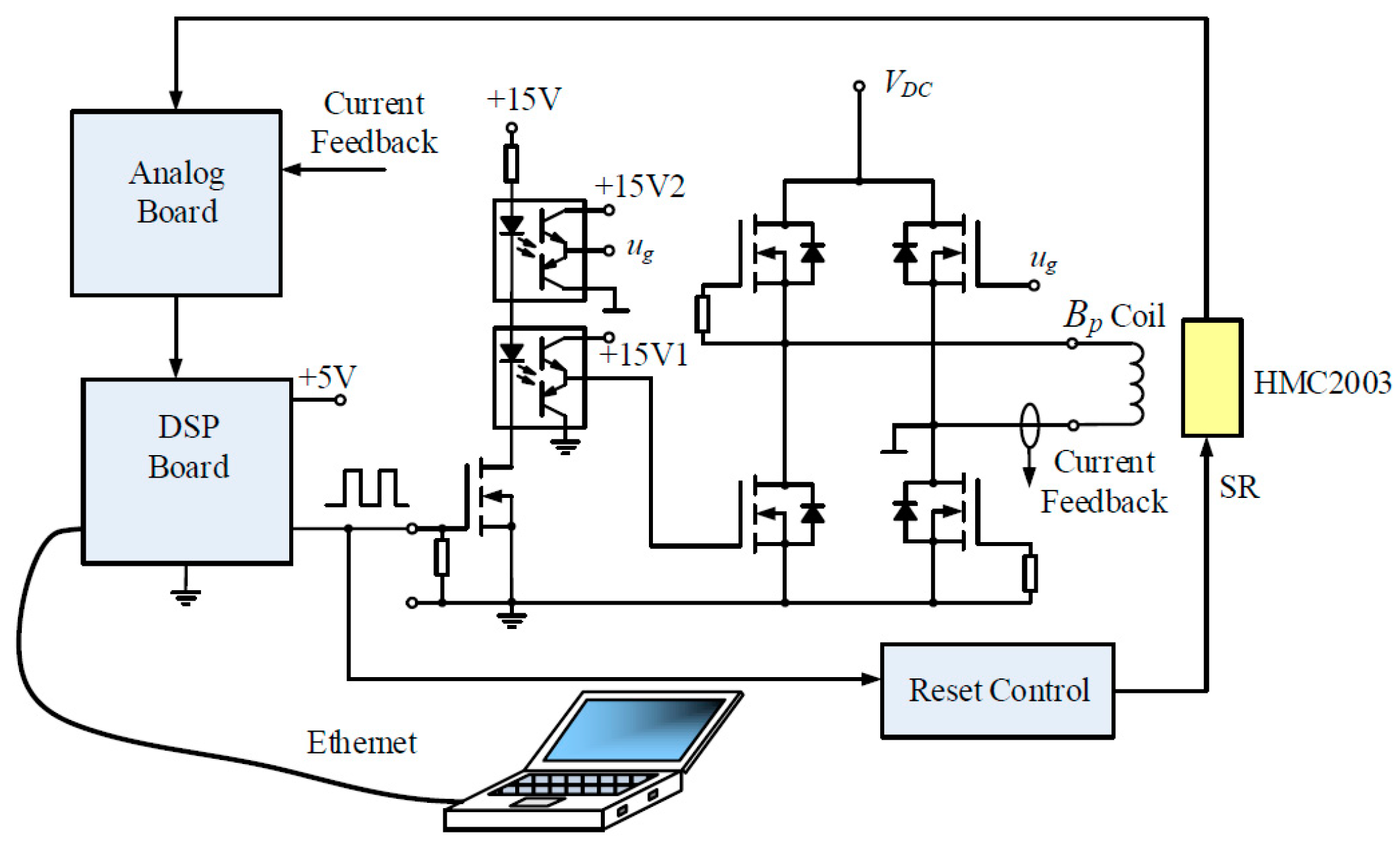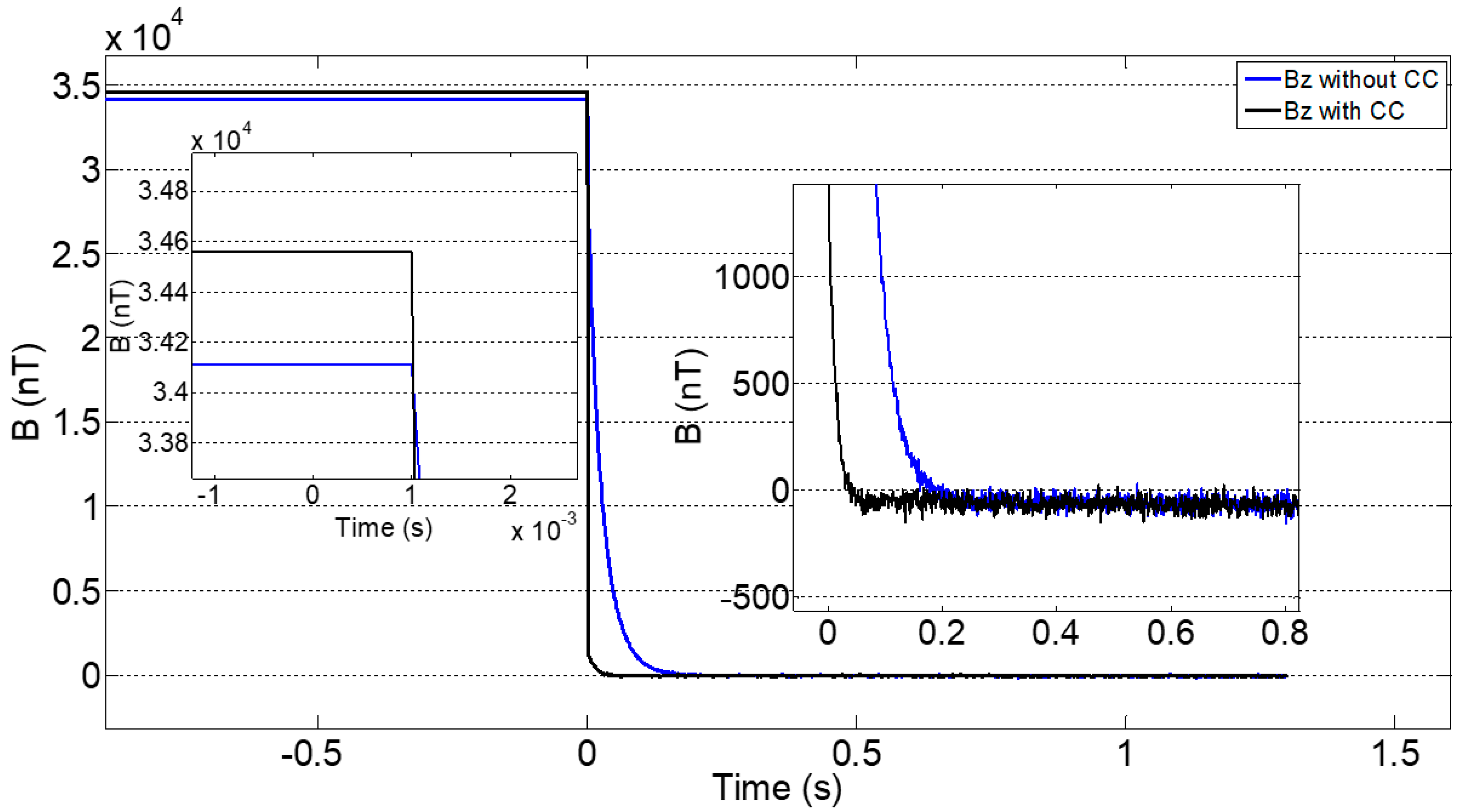1. Introduction
Ultra-low-field nuclear magnetic resonance (ULF NMR) is one of the hot research areas in the applications of superconducting quantum interference device (SQUID) [
1,
2,
3]. Compared with the measurement field
(Bm) strength in the conventional high-field apparatuses (HF-MRs) [
4], the measurement field strength in ULF NMR is several orders of magnitude lower, which brings some advantages including inhomogeneous line broadening comparable to natural line widths or narrower, absence of distortion artifact with metal and chemical shift due to the strong main field and ease of
Bm tuning over many octaves. As well as lower cost and decrease in volume, it is possible to obtain unique images with enhanced longitudinal relaxation time contrast [
5]. The significantly lower measurement magnetic field in comparison with 1.5 T hospital MRI or 9 T lab MRI causes the reduction of signal-to-noise ratio, thus normally ULF NMR introduces strong pre-polarizing field (
Bp) and works in magnetically shielded environments [
6]. A pulsed
Bp whose amplitude is 2–3 orders-of-magnitude stronger is critical to SNR enhancement since the signal amplitude is proportional to
Bp strength [
7,
8,
9,
10]. However, pulsed operation of the
Bp coil may magnetize and induce large eddy currents around shielding structures such as a magnetically or conductive shielded room. The transient magnetic field generated by the eddy currents may cause severe image distortions and signal loss, especially when the large pre-polarizing coil are employed for in vivo imaging [
7].
A method for the assessment of magnetic properties of ferromagnetic materials at low magnetic field values was presented by Canova, A. et al. [
11] and they designed a magnetically shielded room which can be effective against low-frequency external magnetic field disturbances. Li B. et al. [
12] calculated and simulated the shielding effectiveness of the shielded room with different thicknesses of aluminum sheets to increase the SNR and improve image quality. Dong H. et al. [
13] according to the relative position of the
Bp coil and the shielded room, described two physical models of the conductive shielded room to simulate the transient fields at the sample position: the
Bp coil plane parallel to the ceiling and floor of the shielded room and the coil plane perpendicular to the walls. In [
14], superconducting connectivity technique was utilized to connect input coil and pickup coil in order to obtain the best SNR of the fetal magnetocardiography signals in a thin magnetically shielded room.
Suppression of the residual magnetic field (
Br) makes it possible to increase the upper value of
Bp and the magnetization intensity of the object to be measured. In [
15], an effective method to design self-shielded polarizing coils for ULF NMR by connecting shielding coils and the polarizing coil in series with reversed currents was presented and the magnetic fields caused by the eddy currents were largely reduced. In their works the residual magnetic field enters steady state at about 300 ms while in our works the residual magnetic field enters steady state at about 110 ms. In [
16], cancellation coils (CC) with discrete current loops connected in serial to the
Bp coil was implemented using the method of inverse problem and it effectively neutralizes the magnetic field produced by the
Bp coil on the SR walls. Zevenhoven, K. C. J et al. [
17] introduced a dynamical cancellation method in which a precisely designed current waveform was applied to a separate coil after turning off the polarizing pulse. Complicated calculation is needed to figure out the cancellation current density distribution in [
16] or the precisely designed cancellation current waveform in [
17], while it was avoided in this study. By changing the number of turns of the CC which is connected in series with the
Bp coil in the designed structure in this study, the residual magnetic field was suppressed effectively.
In this study, to reduce the impact of Br field inside a SR, a simple method which includes a pair of CCs symmetrically distributed along the Bp coil and a control electronics which can generate appropriate current for the Bp coil and the CC is presented. Simulation and experiment both show that this method can effectively suppress the residual magnetic interference in a small-scale SR. Simulation shows that with 70 turns CC, Br decays much faster than without CC and enters stable state very early once the Bp current switched off.
2. Theory
In previous research, it was found that the eddy currents in the SR can be modeled as a superposition of spatial patterns with amplitudes given by the elements of a vector
, we can describe their excitation and dynamics by linear differential equations [
18,
19]
The elements on the diagonal of the symmetric matrix are the self-inductances of the spatial eddy–current patterns and off-diagonal terms are mutual inductances of the spatial eddy–current patterns. The matrix contains the resistances of the current patterns on its diagonal and the off-diagonal “mutual resistances” describe the Ohmic coupling between patterns that share the same conductor. The third term is an electromotive force (EMF) induced by the current I(t) in a coil, which couples to the eddy–current patterns via mutual inductance in the vector .
The connection between magnetic field and eddy current can be expressed as
Here,
is a coupling vector in which elements are corresponding to the points and magnetic-field components of interests [
20] (the superscript
T denotes the transpose).
Residual magnetic interference of pulse-induced transients has a significant influence on the magnetic signal to be measured and the residual magnetic is much smaller than the source magnetic that excites it. To observe it precisely, the residual magnetic shall be measured after the current through the Bp coil is completely switched off, because at that time it will dominate the magnetic field in the SR.
The current in
Bp coil can be expressed as
Here,
is a unit step function,
is the unit pulse function,
is the maximum value of current in
Bp coil. Substituting
into (1) and applying the Fourier transform, one can get
, then
in which
. The
ISR means the inverse-step response.
By applying Fourier transform to (1), we may obtain
. Hence
The inverse Fourier transform is performed to Equation (5) to get (
denotes convolution)
Provided that the magnetic-field response to an inverse step current in Equation (3) is known, the time evolution of the eddy–current magnetic field transient
B(t) caused by any pulse waveform
I(t) can be computed by
Equation (7) is suitable to estimate transient magnetic field for the CC and Bp coil in the SR.
The currents in the
Bp coil and CC are
Ip(t) and
Ic(t), respectively. Suppose the coil have individual inductances
and
with the eddy–current patterns, leading to corresponding magnetic fields,
and
. The third term in Equation (1) becomes
and the total transient magnetic field
B(t) becomes
In this study, the
Bp coil is connected in series with the cancellation coil and they are both completely switched off in 2 ms. We take this moment as
ts = 2 ms. When
t >
ts,
in Equation (1). Equation (1) can be written as
Finally, we can get
where
K is a constant.
K equals zero because in practice the eddy current in a SR will decay to zero. Combined with Equation (2), we can get
Once the currents through Bp coil and CC completely switched off, we write Br(t) as B(t).
Then combining Equations (8) and (12), gives
Based on Equation (13), it can be shown that the residual eddy–current magnetic field can be divided into two parts. The first part is produced by
BP coil and the second part by CC. According to reference [
20], the residual eddy–current magnetic field can be expressed by
Combining Equations (13) and (14), when
t >
ts = 2 ms
Here, N1 and N2 are positive integers; , and are positive numbers; is a negative number; Br1(t) and Br2(t) represent the eddy–current magnetic field generated by BP coil and CC coil in the SR, respectively and they are mutually offset.
3. Simulation
As a demonstration, a small-scale copper conductive SR was designed with dimension of 280 mm × 280 mm × 300 mm, and the wall thickness was 10 mm, as shown in
Figure 1a. A pair of CCs was symmetrically configured above and below the
Bp coil whose distance to each CC was 46 mm and the distance from
Bp coil to the center of floor was 110 mm in the SR. The pair of CCs were connected in series with the
Bp coil, so the current in the
Bp coil was the same as that in the CC, but with opposite directions. The current was switched off in 2 ms. The parameters of the
Bp coil and CC were shown in
Table 1. The current through the
Bp coil during the simulation is shown in
Figure 1b.
Figure 2 shows the comparison of residual magnetic field component in z direction without and with CC measured with the magnetic sensor HMC2003. It can be seen from
Figure 2 and
Table 2,
Br decayed much faster with the 70 turns CC configuration (In this configuration, the number of turns of CC was 70) than with no CC. When
t > 10 ms, the
Br with 70 turns CC had already entered a very low stage and most of the attenuation occurs before 10 ms.
The number of turns of CC had a significant impact on the effect of the cancellation.
Figure 3 shows the residual magnetic field at the measuring point when the number of turns of the CC changed from 64 to 78.
Figure 3a shows that the suppression effects of the residual magnetic field were quite obvious and
Figure 3b shows the comparison of the suppression effects with different number of turns of CC.
From
Figure 3, it can be seen that the best result occurs when the CC has 70 turns. However, overshoot of the cancellation of the eddy–current magnetic field can be observed under this condition, partly because the dimensions of the cancellation coil have not been optimized well enough, which will be an important aspect to be studied in the future.
It can be seen from the analysis in
Section 2 that the acquired measurements
Br(t) can be treated as a linear combination of exponentially decaying signals with multiple distinct time constants.
According to [
20], we set
,
,
.
,
and
are positive numbers and
is negative.
The expression of fitting curve
Bz-fix1 in
Figure 4 is
Because there is no CC in this configuration and only the residual magnetic field in z direction is considered, eddy–current magnetic field is generated only by Bp coil in simulation.
Br1 represents the eddy–current magnetic field generated by the Bp coil.
The expression of fitting curve
Bz-fix2 in
Figure 5 is
Because there is CC in this configuration and only the residual magnetic field in z direction is considered, eddy–current magnetic field is generated by Bp coil and CC in simulation.
Combining Equations (19) and (21), we can get the expression of the eddy–current magnetic field generated only by CC,
Therefore, we decouple the eddy–current magnetic field produced by the
Bp coil and the CC in SR in simulation after the current is completely switched off at
ts = 2 ms into two parts:
To date, we have simulated the suppression effect of the SR with CC on the eddy–current magnetic field and decoupled the eddy–current magnetic field produced by the Bp coil and the CC by data fitting. We will now experimentally verify these theoretical predictions.
4. Experimental Results
An equipment representative of the configuration previously studied was manufactured, as illustrated in
Figure 6, with a plastic holder supporting coil inside the SR. The current through the
Bp coil,
Ip, during the measurement was set as shown in
Figure 7. In the experiment, the current
Ip was generated by control electronics and we used the magnetic sensor HMC2003 to monitor the the residual magnetic field. After the current
Ip was completely switched off at 2 ms, the CC which was connected in series with
Bp coil can effectively suppress the residual magnetic field in the SR.
The control electronics which can be seen in
Figure 8 was used to generate the
Ip. The
VDC was provided by the adjustable source voltage and the voltage was adjusted according to the required turn-off time. By increasing the source voltage, we can turn off the
Ip faster. The analog board was used to amplify the current feedback signal to realize the closed-loop control. The function of reset control circuit was used to reset the magnetic sensor HMC2003 and make it recover from the saturation state under the external magnetic field.
Control logic of the electronics: the computer was connected to the DSP board through Ethernet and the DSP board outputs an interface to connect to the driver board. When it was needed to measure, the computer sends instructions to the DSP board (through Ethernet) and the DSP outputs PWM level on the port. At the same time, it detects the data of the current sensor, adjusts the PWM width to make the current Ip = 0.48 A, and lasts for a fixed time (> 2 s so that the eddy–current magnetic field produced by the rise of Ip had disappeared), and then sets the output to low level in 2 ms, completing one complete on/off cycle of the current Ip. The measurement windows of most ULF NMR fall between 10 ms to 2 s, so effective reduction of Br after 10 ms had a dominating impact on ULF NMR. By reducing the turnoff time of the current Ip, we can advance the measurement time of ULF NMR.
The measured
Br without and with CC are shown in
Figure 9. At the beginning, the field of measured point keeps unchanged at around 35,000 nT until
t = 1 ms. This was because the magnetoresistive sensor employed to measure the magnetic field remains saturated, and it was unable to reflect the actual strength of the magnetic field before
t = 1 ms. Indeed, the magnetic field produced by the
Ip = 0.48 A in the z direction was 1.79 mT, which exceeded the measuring range of the magnetoresistive sensor; the magnetic field produced by both
Ip = 0.48 A and
Ic = 0.48 A in the z direction was 1.68 mT, which also exceeded.
Br and its attenuation without and with CC at different times were shown in
Table 3 and
Table 4, in which the values come from the magnetic field waveform in
Figure 9. It can be seen that without CC, when
Ip was completely switched off at 2 ms, the attenuation of modulus value of
Br at the measuring point in the SR was 98.42% while the attenuation was 99.89% with CC at the same time. The eddy–current magnetic field dominates
Br when
Ip was completely switched off at 2 ms. At this moment, the
Br was 1851 nT with CC compared to 28,310 nT without CC, which was significantly suppressed. After
ts = 2 ms, only the eddy–current magnetic field was left in the SR. Compared with the modulus value of
Br at 2 ms, the attenuation of the modulus value of
Br at 10 ms without CC was 28.40%, while the attenuation reaches 63.82% with CC; At 50 ms, the attenuation of modulus value of
Br without CC was 83.59% while the attenuation was 97.09% with CC. It was demonstrated that with CC, the
Br was significantly reduced in the SR, making great contribution to the improvement for suppressing the residual magnetic interference so that we can advance the measurement time of the ULF NMR and improve the SNR.
Figure 9 indicates that the
Br (residual magnetic field in z direction) attenuates exponentially as a result of the eddy currents in the SR, therefore the time constants and amplitude of the magnetic field modes can be obtained by the measured data through curve fitting.
It was necessary to pay more attention to the range of data selected for curve fitting. The end time of the data to be fitted should be the time when Br enters into an almost unchanged steady state, which corresponds to the end of the attenuation process. The reason was that the accuracy of the used magnetoresistance sensor was not high enough and when the magnetic field Br enters the steady state and gradually tends to zero, the measured data of the magnetoresistance sensor was disturbed by noises, which will oscillate around zero. If the end time was too long, it affected the fitting accuracy.
As shown in
Figure 9, the blue and black curves represent the original value of
Br without and with CC, respectively. We fit the two curves after
ts = 2 ms in
Figure 10 respectively when currents were completely switched off.
In Equation (17), we still set
,
,
. The expression of fitting curve
Bz-fix1 in
Figure 10a is
Because there is no CC in this configuration and only the residual magnetic field in z direction is considered, eddy–current magnetic field is generated only by Bp coil.
Br1 represents eddy–current magnetic field generated by Bp coil.
The expression of fitting curve
Bz-fix2 in
Figure 10b is
Because there is CC in this configuration and only the residual magnetic field in z direction is considered, eddy–current magnetic field is generated by Bp coil and CC.
Combining Equations (25) and (27), we can get the expression of the eddy–current magnetic field generated only by CC,
Therefore, we decouple the eddy–current magnetic field produced by
Bp coil and CC in the SR after the current is completely switched off at
ts = 2 ms into two parts:
It can be seen from 10 that the curve fittings are satisfactory.
Br is decoupled into the superposition of
Br1 and
Br2, which makes it possible to deeply analyze the relationship between the attenuation signal
Br and the structure of SR with CC in the future [
7].
5. Conclusions
In this study, a pair of effective cancellation coils connected in series with the Bp coil was designed for suppression of the residual magnetic interference in a SR. Simulation and experiment in a small-scale SR demonstrate that this method was effective in reducing the influence of the eddy effect. Simulation shows that with 70 turns CC, Br decays much faster than without CC. Experimental results show that, with the same current in the Bp coil the modulus value of Br with CC was 1851 nT when the current was completely switched off at two milliseconds, while the modulus value of Br without CC was 28,310 nT. When compared with the modulus value of Br at two milliseconds, the attenuation of modulus value of Br with CC was 97.09% (the modulus value of Br attenuated to 53.92 nT from 1851 nT) while the attenuation was 83.59% without CC at 50 ms (the modulus value of Br attenuated to 4647 nT from 28,310 nT). It was thus demonstrated that with CC, the Br was significantly reduced in the SR which makes great contribution to the improvement for suppressing the residual magnetic interference. Therefore, we can advance the measurement time of the ULF NMR and improve the SNR.
Through theoretical derivation and experiment, the eddy–current magnetic field produced by Bp coil and CC in the SR was decoupled into two parts after the current was completely switched off at two milliseconds and the mathematical expressions were obtained. Therefore, it was possible to deeply analyze the relationship between the attenuation signal Br and the structure of SR with CC in the future.
Although a notable improvement was achieved for suppressing the residual magnetic interference in this work, further improvement on this scheme was still required, especially on the optimization of the size and structure of the cancellation coil, to obtain a better cancellation of the residual magnetic interference. In addition, the application of this method to a full-scale SR needs to be studied in the future.

